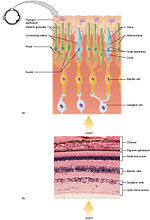Double cones (DCs), known as twin cones when the two members are the same, are two cone cells (colour detecting photoreceptors) joined together that may... 3 KB (382 words) - 18:15, 30 August 2022 |
 | channels for conveying color information, or possessing four types of cone cell in the eye. Organisms with tetrachromacy are called tetrachromats. In... 24 KB (2,684 words) - 14:02, 13 April 2024 |
 | As a part of the retina, bipolar cells exist between photoreceptors (rod cells and cone cells) and ganglion cells. They act, directly or indirectly, to... 6 KB (742 words) - 06:44, 18 July 2023 |
 | Color vision (section Cone cells in the human eye) up: Perception of color begins with specialized retinal cells known as cone cells. Cone cells contain different forms of opsin – a pigment protein – that... 64 KB (7,831 words) - 19:37, 14 April 2024 |
 | Photopic vision (redirect from Cone cell vision) many other animals, photopic vision allows color perception, mediated by cone cells, and a significantly higher visual acuity and temporal resolution than... 4 KB (367 words) - 21:16, 8 April 2024 |
Achromatopsia (section Blue cone monochromacy) in the cone cell cyclic nucleotide-gated ion channels CNGA3 (ACHM2) and CNGB3 (ACHM3), the cone cell transducin, GNAT2 (ACHM4), subunits of cone phosphodiesterase... 26 KB (2,928 words) - 00:54, 8 April 2024 |
 | Fovea centralis (section Angular size of foveal cones) belt, where the ganglion cell layer is composed of more than five layers of cells, as well as the highest density of cones; the perifovea is the outermost... 26 KB (2,989 words) - 16:35, 26 April 2024 |
 | about color by processing signals from cone and rod cells in an antagonistic manner. The three types of cone cells have some overlap in the wavelengths... 24 KB (2,916 words) - 02:31, 22 March 2024 |
are characterised by initial loss of rod photoreceptor cell function followed by that of the cones and for this reason night blindness is the first significant... 12 KB (1,592 words) - 03:05, 3 December 2023 |
Look up cone or coning in Wiktionary, the free dictionary. A cone is a basic geometrical shape. Cone may also refer to: Cone (category theory) Cone (formal... 8 KB (1,285 words) - 23:47, 7 April 2024 |
 | viability factor, RdCVF) that protects the cone cells from apoptosis (cell death). However, when the rod cells die, this substance is no longer provided... 63 KB (6,401 words) - 07:21, 15 April 2024 |
 | Peripheral vision (section Cone-rich rim of the retina) distribution of receptor cells across the retina is different between the two main types, rod cells and cone cells. Rod cells are unable to distinguish... 25 KB (2,853 words) - 18:31, 23 April 2024 |
the eye reports input from short wave blue cone cells along with a sub-sensitivity of the long wave cones which respond secondarily to that same deep... 21 KB (2,418 words) - 01:04, 23 April 2024 |
third class of photoreceptors, in addition to rod and cone cells. Compared to the rods and cones, the ipRGCs respond more sluggishly and signal the presence... 26 KB (3,103 words) - 19:54, 25 April 2024 |
 | Color blindness (section Based on affected cone) variation in the functionality of one or more of the three classes of cone cells in the retina, which mediate color vision. The most common form is caused... 93 KB (10,129 words) - 19:38, 27 April 2024 |
 | CIELUV color space. The human eye with normal vision has three kinds of cone cells that sense light, having peaks of spectral sensitivity in short ("S",... 55 KB (7,503 words) - 12:25, 8 April 2024 |
 | may imply that they have been modified from a cone cell ancestor. They occasionally occur in double cones/double rods. Some oil droplets are coloured,... 3 KB (330 words) - 18:26, 16 February 2024 |
 | A cone dystrophy is an inherited ocular disorder characterized by the loss of cone cells, the photoreceptors responsible for both central and color vision... 11 KB (1,318 words) - 08:41, 2 April 2024 |
 | amacrine cells synapse with retinal ganglion cells. The synapses in the outer plexiform layer are between the rod cell endings or cone cell branched foot... 2 KB (142 words) - 21:13, 21 November 2021 |
 | Retina (redirect from Cone mosaic) pigmented epithelial cells. The primary light-sensing cells in the retina are the photoreceptor cells, which are of two types: rods and cones. Rods function... 84 KB (9,293 words) - 09:08, 8 April 2024 |
is the state of having two types of functioning photoreceptors, called cone cells, in the eyes. Organisms with dichromacy are called dichromats. Dichromats... 15 KB (1,711 words) - 22:04, 25 April 2024 |
Scotopic vision (redirect from Rod cell vision) sight'. In the human eye, cone cells are nonfunctional in low visible light. Scotopic vision is produced exclusively through rod cells, which are most sensitive... 11 KB (1,208 words) - 11:56, 26 April 2024 |
 | four types of cone cells each with a distinctive maximal absorption peak. In some birds, the maximal absorption peak of the cone cell responsible for... 68 KB (8,330 words) - 02:32, 11 December 2023 |
of cones, rather than each type of cone's individual response.[citation needed][dubious – discuss] Color blindness can be classified by the cone cell that... 30 KB (3,499 words) - 04:35, 23 February 2024 |
 | Vertebrate visual opsin (redirect from Cone opsin) mediate vision in vertebrates. They include the opsins in human rod and cone cells. They are often abbreviated to opsin, as they were the first opsins discovered... 10 KB (995 words) - 11:25, 26 April 2024 |




